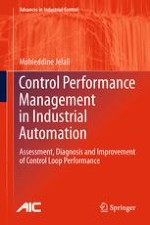2013 | Buch
Über dieses Buch
Control Performance Management in Industrial Automation provides a coherent and self-contained treatment of a group of methods and applications of burgeoning importance to the detection and solution of problems with control loops that are vital in maintaining product quality, operational safety, and efficiency of material and energy consumption in the process industries. The monograph deals with all aspects of control performance management (CPM), from controller assessment (minimum-variance-control-based and advanced methods), to detection and diagnosis of control loop problems (process non-linearities, oscillations, actuator faults), to the improvement of control performance (maintenance, re-design of loop components, automatic controller re-tuning). It provides a contribution towards the development and application of completely self-contained and automatic methodologies in the field. Moreover, within this work, many CPM tools have been developed that goes far beyond available CPM packages.
Control Performance Management in Industrial Automation:
· presents a comprehensive review of control performance assessment methods;
· develops methods and procedures for the detection and diagnosis of the root-causes of poor performance in complex control loops;
· covers important issues that arise when applying these assessment and diagnosis methods;
· recommends new approaches and techniques for the optimization of control loop performance based on the results of the control performance stage; and
· offers illustrative examples and industrial case studies drawn from – chemicals, building, mining, pulp and paper, mineral and metal processing industries.
This book will be of interest to academic and industrial staff working on control systems design, maintenance or optimisation in all process industries.
Anzeige
